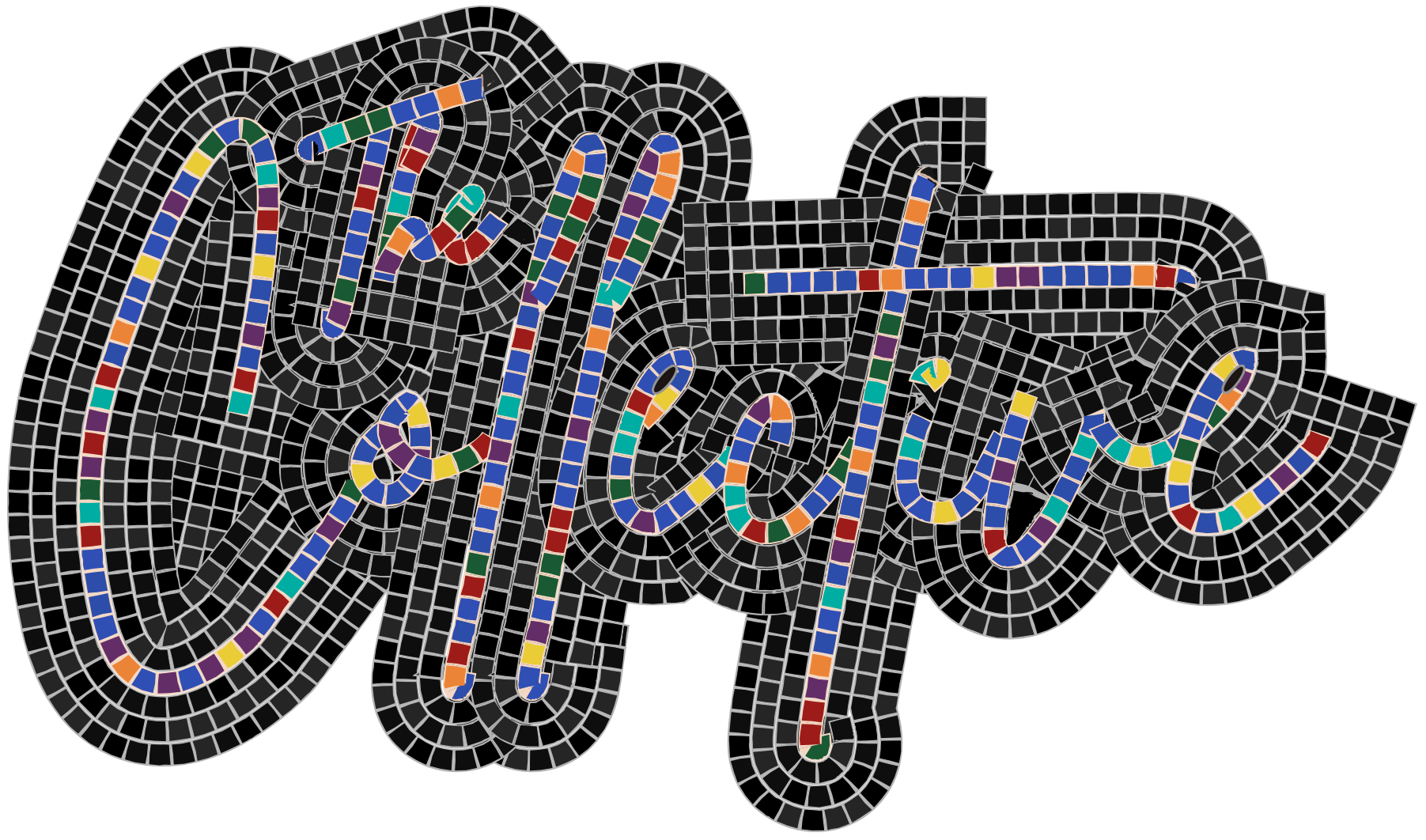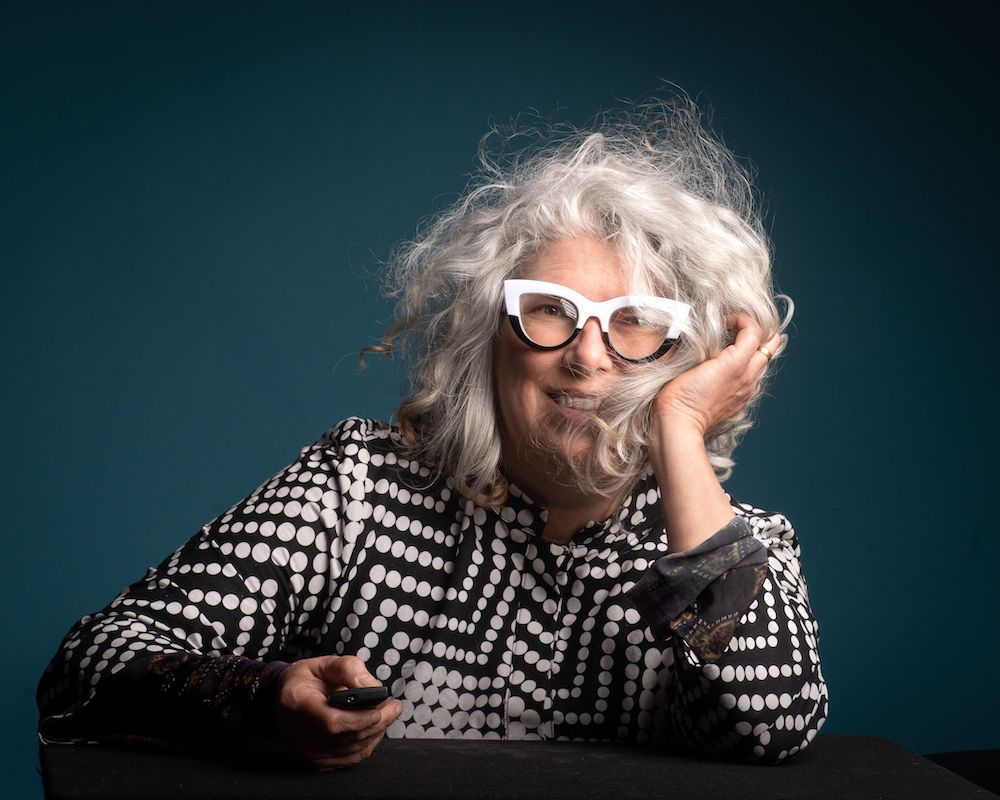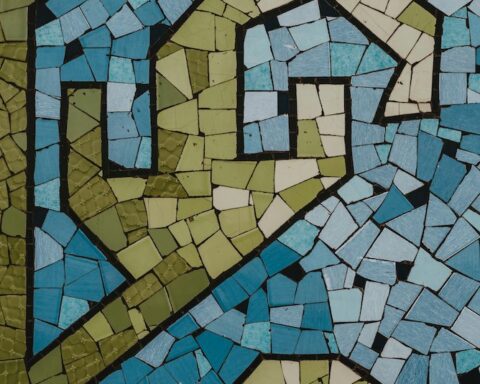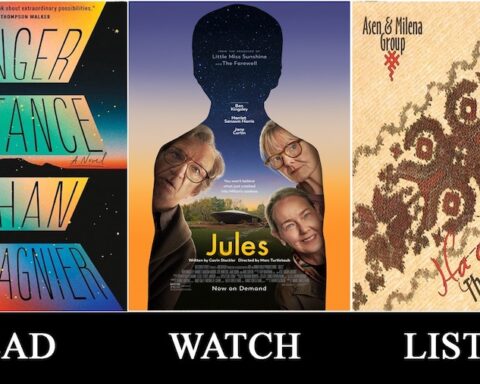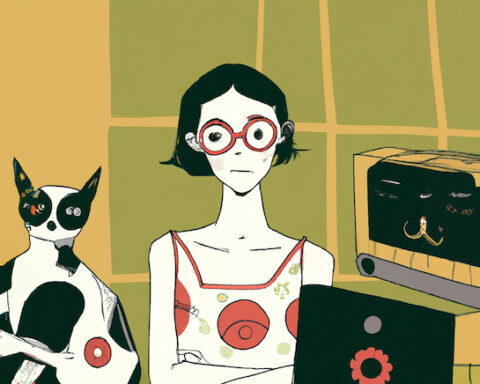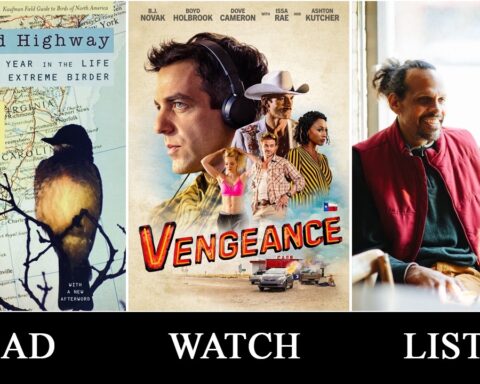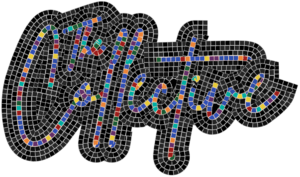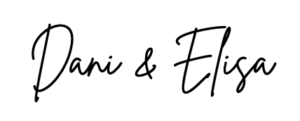Editors Dani and Elisa were delighted to speak with Tina Gutierrez about her multifaceted artistic background and philosophies. This interview took place on October 26 over a Zoom video call.
Tina Gutierrez is a Cincinnati-based visual artist and musician. She prefers to be called an “arts instigator,” working with communities to bring attention to difficult or challenging issues through thought-provoking projects. Tina has taught at the Art Academy of Cincinnati and been guest lecturer at the University of Cincinnati (DAAP, CCM) and Xavier University. Tina’s work has been widely exhibited in her region as well as in Havana, Cuba and Mexico City, and published in many international magazines. Tina’s practice is grounded in her study of art, movement, and music. She is a longtime student of Developmental Movement, including Feldenkreis and Alexander Technique, and very deliberately composes the human figure and its activity. Tina performs widely on the lute and Renaissance flute and directs the early music chamber group, The Shakespeare Band. Her cultural connection to the Renaissance and Baroque periods extends beyond music to the visual world, especially sculpture. Depicting classical balance and beauty in the human form is a hallmark of Tina’s work. When not composing scenes in the studio or on-site, Tina is a freelance photographer with a broad clientele, including many Grammy award-winning musicians. Tina is strongly involved with social justice photography and believes that the camera is a tool for change. She works to create images that show the beauty of humanity, enabling others to express their fears, hopes, and dreams, while also creating hope and healing in individuals and communities.
Trigger warning: this interview contains references to sexual assault, which some individuals may find distressing.
Dani. I want to open with this “arts instigator” idea — can you talk about how and why you identify as an instigator, and how this idea works with all the different art forms you engage in?
Tina. So people kept asking me, What do you do? What are you? and I’m like, I don’t know… In the Renaissance, people did play music, they did read, they did do all of these different things, and it wasn’t this weird thing, it was something everyone did. And now it’s this anomaly. So, I thought, How can I identify? What do I identify myself as? I thought art activist because I do photography activism. But that’s not what I am, that’s just a small part of what I do. So, I was playing around with words and the word instigator came up. I do like to start things, I like to have projects, and to do community projects, too. I really love motivating people to take part, or to find where they have a place, in a work or in a community, or to try to help them find what their singular voice is, or plural voice, or whatever voices. And I have kind of a game side, too; I like playing games and making up games at parties. I liked the idea of instigator because it seemed to combine all of those things with just a little air of mischief.
Dani. The mischief aspect is so fun! So, this Renaissance idea and how it’s sort of an anomaly now for people to do multiple art forms… can you talk a little bit more about that, and how you came to be so involved with so many different forms? Was that something you did intentionally? Was it natural?
Tina. Well, when my sister and I were kids, my mom would just put us in all the different classes — she loved art, she was a visual artist. There was always a guitar around the house, so I started taking guitar lessons, and that became my instrument. I really worked hard on classical guitar, played a little bit of flute, then I majored in music, and later my husband Larry and I started doing dance. I always loved dance. Mostly we were doing historical social partner dancing; we also spent a month in Argentina learning the tango. I studied developmental movement for about fifteen years with Fanchon Shur, a modern dancer who I consider my main mentor. I play the lute now, too. What’s really cool is that Larry is a luthier, a very, very fine luthier. And so, he builds the instruments and I play them! But, I just… I just love all of it. I’d probably be better at one [thing] if I stuck with it, but I don’t — I can’t. I’ve had some really hard conversations with myself about it, and I’m like, No, I’m gonna do all of them.
Dani. That’s amazing… so different from the sort of over-professionalization and/or over-specialization that so often happens. That’s not to say there’s not value in that, too. It’s just different.
Tina. To be fair, I had given music up right after I got out of school. I didn’t really even touch it for about ten years. So, I had some time to develop, to go head-on into other things and really apply myself. I think that if I had still been doing music full-time, it would have been much more difficult to do that. And I always loved photography — I did photography in college, and I loved it as a kid. I remember when I was eight or nine, and my sister got a camera for her birthday, and I just cried [laughs]. I wasn’t a spoiled kid — we knew that you should be happy for the other person — I just didn’t know that a human being could have a camera! [laughs] Same thing happened when I got my first guitar; I was just a mess. But seeing this camera… I’m like, I need it. So, my parents finally got me one, and I did that for a little bit, but I didn’t really do it seriously until probably ten years ago.

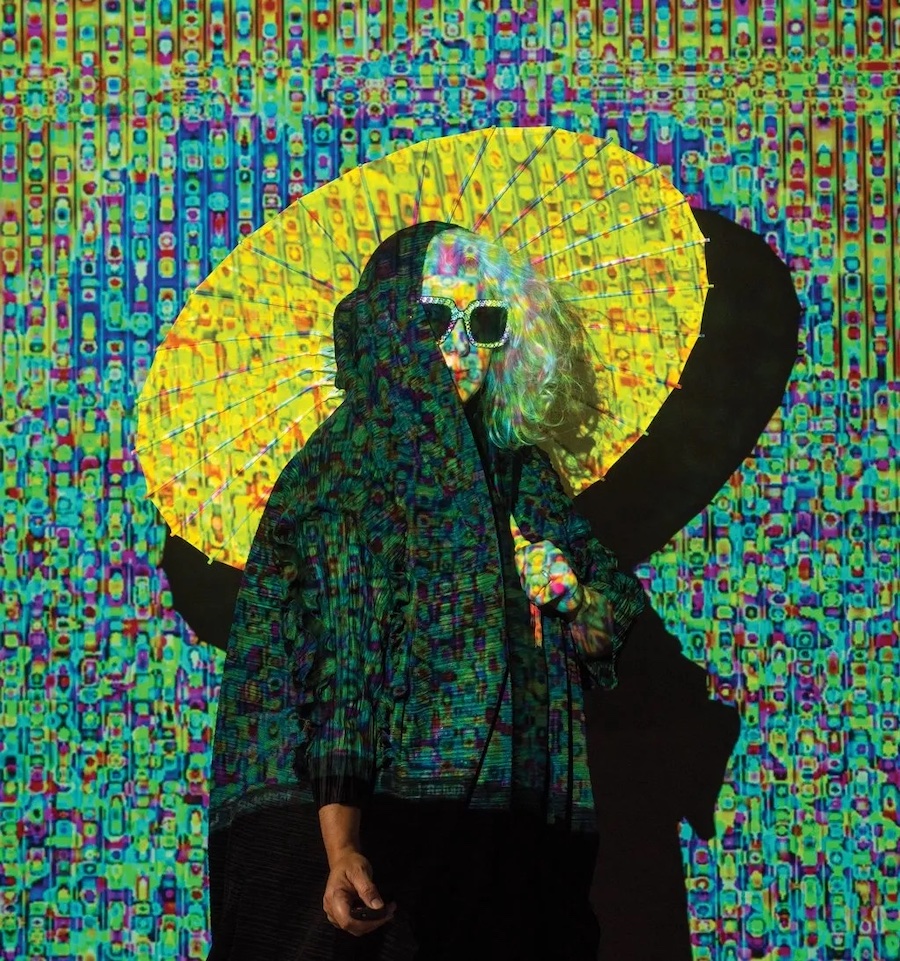
Elisa. You say you gave up music right after you graduated — was there a reason for that?
Tina. Um, yeah, there was. I was raped.
Elisa. I’m so sorry.
Tina. You know, it’s nice to be able to just say it now. There were decades when I didn’t. There was a lot of shame. But now I feel old enough and confident enough to really talk about it… It goes on everywhere, though.
Dani. Thank you so much for sharing that with us, and yes, it’s such a huge part of our culture . . . especially with the MeToo movement, and I’ve been thinking about this a lot in terms of the performing arts and music. It’s grossly prevalent in academia and higher-level performing.
Tina. Oh, I’m sure you heard what happened at CCM with the flute professor there?
Dani. Yes, of course, I was actually there the year before everything went down. Ugh… Was there any justice for you?
Tina. No! None whatsoever. None whatsoever. And I was so inspired by the whole MeToo thing, but… I just had to make a decision about what I wanted my life to be about. And I’m 58 years old now! When it happened to me, and I was 22, I didn’t know what to do. I was a mess. It was the most horrible thing that could have happened.
Dani. Wow. I’m so sorry. This experience must have shaped your trajectory as an artist?
Tina. Well, I don’t think that particular situation was the only thing. That shaped my love for women’s issues, but there were so many experiences that shaped me. Probably one of the biggest things that shaped me is… I’m half Cuban, and when I was much younger, I had darker skin, and my hair was black. And now it’s very interesting to see, as I get older, and I’m paler, and my hair is white now, how I’m completely treated differently — I’m treated as a white person. And because I’m only half Cuban, you would never really look at me and say, Oh, Hispanic!, you’d look at me and be like, Oh, yeah, she’s something. So, that gave people the opportunity — people that were racist because they felt that I was white — to talk to me in ways that were extremely racist that they never would have done otherwise. It gave me a perspective about how fearful people are. And I’ve struggled with this for years, about how to portray racial harmony.
When I was younger, I was probably more fixated on showing the problem, and I think that’s a really important part of art and should absolutely be shown, over and over and over again. But I also feel like there’s this big need to show the solution. That is what I focus on, primarily, with my work. Except, when Roe v Wade got overturned, I did some ugly, bloody pictures. That was the first time I actually did anything that’s really what I would consider more violent in nature, because I was just so mad, as so many of us are. But showing the solution for racial harmony to me meant envisioning this world that I want to live in. What does it look like?
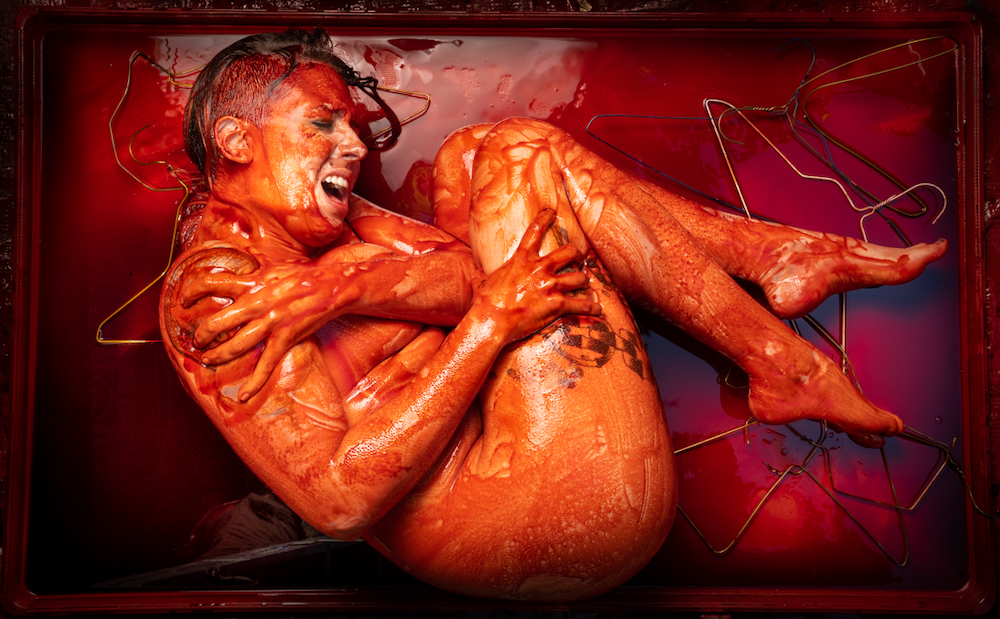

Dani. So, there’s a world-building element in your artwork at this point, like this is the world that you want to live in, and you’re showing that, essentially.
Tina. Yeah, because I really believe that humans, just like many animals, are territorial — we look for patterns and for things that look different. Anything outside of our pattern recognition is an alert. It’s sort of a fear thing. And then if somebody isn’t there to say, Oh, no, this is just my friend, they look different, but they’re fine, then the initial reaction is to be fearful, to push away. I really feel like if we can show the opposite of that and show people interacting harmoniously, that can relieve some of the fear. I don’t know if it works, but it makes me feel better. Like the hand mandalas series — that’s probably the most successful, as far as people buying them and putting them in their offices — if they want to make a statement about race, or anti-racism, and they want to do it in their work situation, they can put up one of these because it doesn’t say anything, they don’t offend anyone… they just show people interacting harmoniously together.
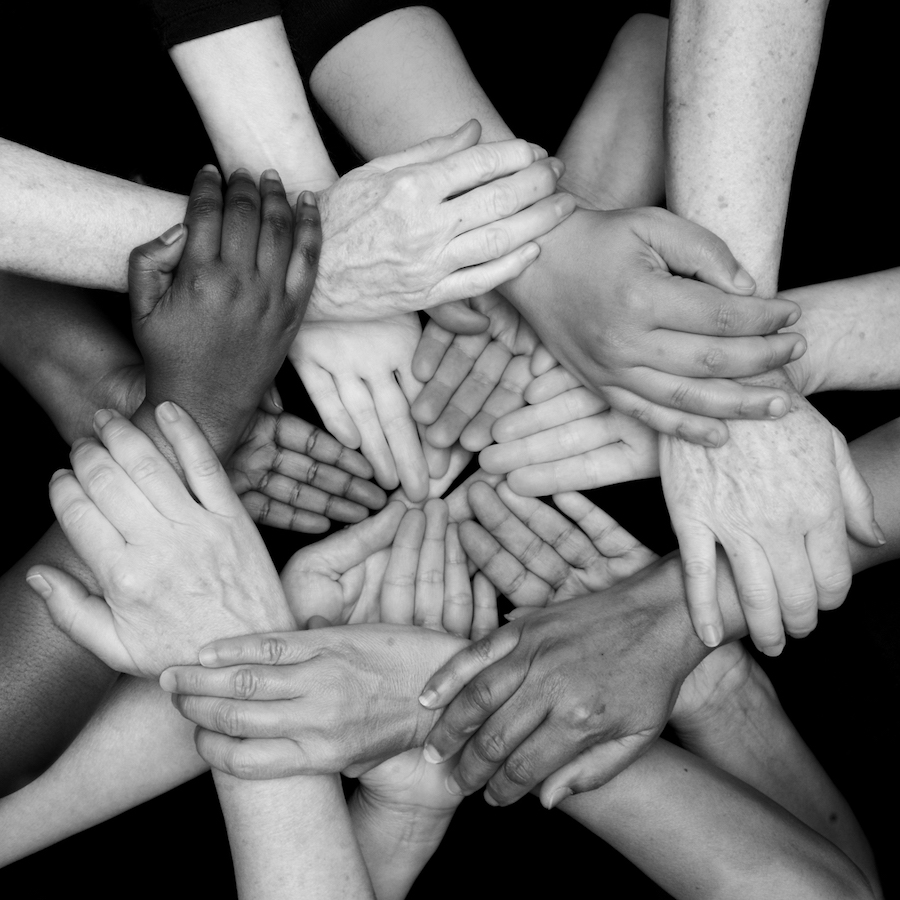

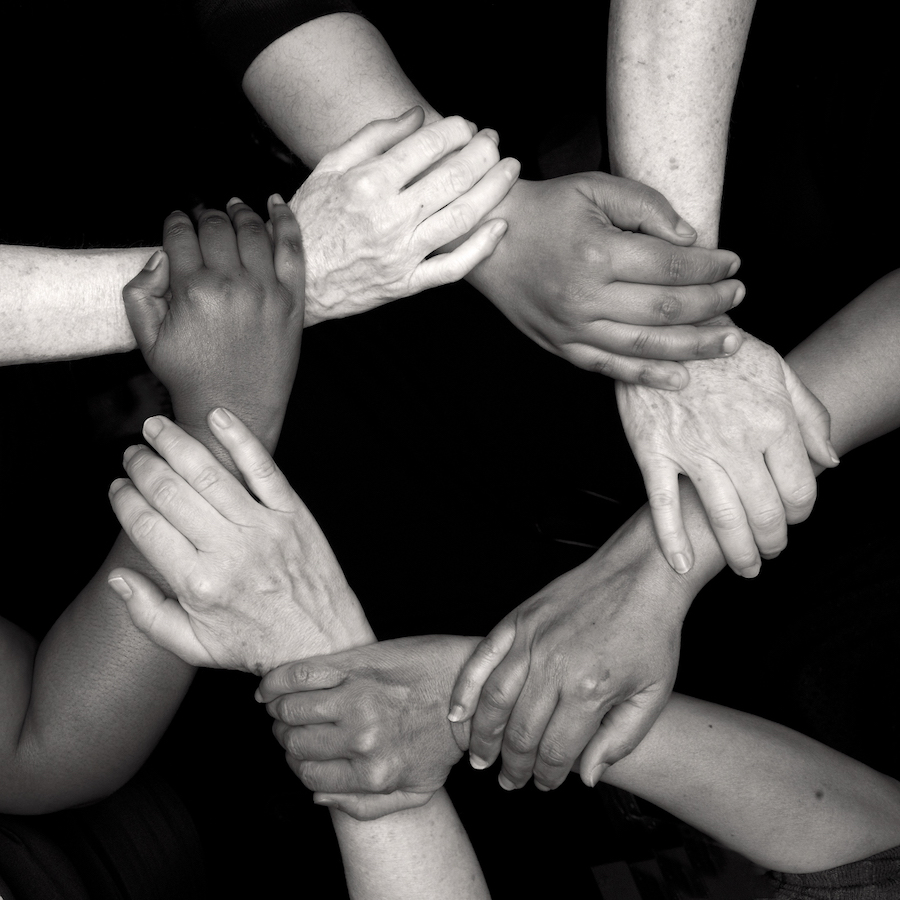

Photographs from Tina Gutierrez’s “Colors of Women — Hand Mandalas” series
Dani. So, you said it makes you feel better. What about the people that you work with, the people that you photograph? How are you connected with them? How does this support them, and what do they take from the process?
Tina. When we did the hand mandalas, it was right around that women’s march in Cincinnati after the 2016 election. Some of these people I met at the march, some were friends, some asked other people that they knew… I had attempted things like this before, but there would be only white people. And I’m thinking, Okay, we can’t do this with all white people. [laughs] So then the next time, I say, Okay, you’ve got to bring somebody else. You’ve gotta bring somebody who does not look like you, and the more they don’t look like you the better. So many white people say, yeah, I believe in it, but then they don’t do anything. So that part of the instigation thing is: Okay, how can they not just talk about it, but actually DO something? And that thing is to go and get somebody and say, Hey, I feel this way, how do you feel? Would you like to do this project together? And so, all these people came together in the studio, and they left friends. It was really cool! People found out they were neighbors, they already had these other connections — just like any other networking thing — but they all have these shared values. I’ve done a couple other similar projects like that. But the rule now is they have to bring somebody who doesn’t look like them.
Dani. That’s awesome, Tina. Very tangible, like you’re saying to the people involved, you must do this, it will create change, and it makes people’s lives different. This makes me think of the wearable art project you did during the pandemic. How did that one work, logistically? And what was the effect on people?
Tina. I think it was probably the second or third night of the pandemic, and I’m lying there with the blankets over my head (you know, we were all news scrolling, doom scrolling) and I couldn’t sleep, I’m thinking, clearly my business is over — you know, playing music was out, doing photography was out. Most of my good ideas come at three o’clock in the morning, so, I woke up one night, and thought, Oh, yeah, I love costumes… How can we do something interpretative? Okay. I’m going to ask people to make a costume to express how they feel, visually, about COVID. I put something up on Facebook, and it got, like, ten people the first time.




Photographs from Tina Gutierrez’s COVID-19 Wearable Art Response Project
I was never really an outside shooter, so I got better as a photographer — that was great. It kept me sane because at least once a week, sometimes two or three or four times a week, for two years, I was out photographing somebody. And for some of the people it was just so therapeutic; they were saying, I needed to do something, I needed to get out of the house. I had some people who made three or four different costumes, like they needed to do it just as badly as I needed to take their picture. We worked in the park, and I used a long lens so we could be separate. At that time, photographers, even in photographic communities or professional photographic organizations, were really angry at any photographer who would do anything at all. For a while, I was being really given a hard time, so that’s when I started doing self-portraits and coming up with my own costumes.
And you know, what was cool is nobody in those pictures was a victim. They all portrayed power figures. Like, almost shamanic power figures. They had wands and staffs, and they were monsters; it was a no victim zone. And I didn’t tell people what to do either; they just did what they needed to do. And I really believe in the power of what we channel when we take on a costume or another persona, when you play a piece of music, and you think, Okay, who am I in this piece of music?, especially if it’s program music, How am I feeling? And so much in this culture, we’re not given permission to do that. But costumes and music and art let us do that.
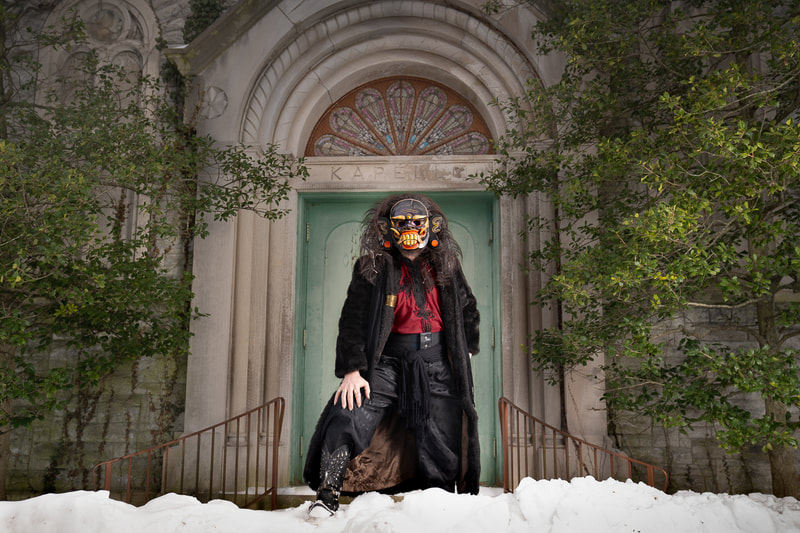

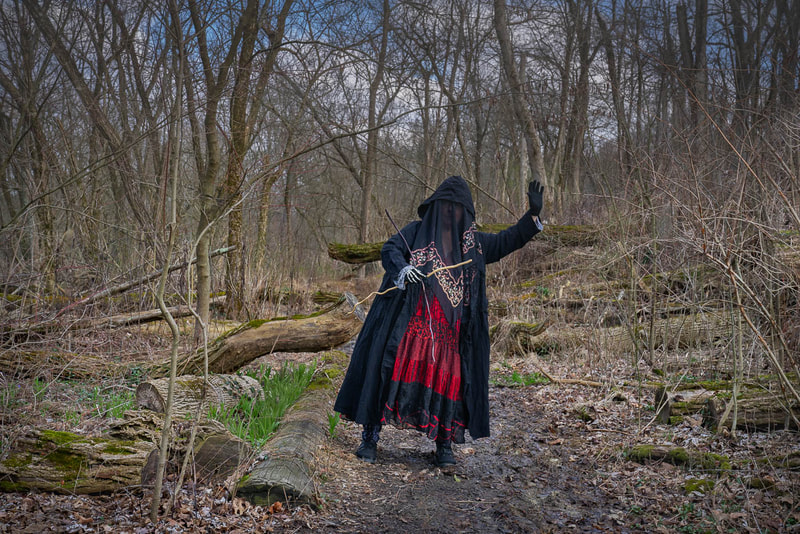
Photographs from Tina Gutierrez’s COVID-19 Wearable Art Response Project
Dani. How did you get into making costumes?
Tina. When my husband and I were dancing, we had to come up with our own costumes. I can’t really sew; I’m not a sewer, I call myself more of a costume assembler. So, I’d think, How can you assemble things in unusual combinations? Things that are sort of unexpected? And then attach them with, you know, zip ties, or staple guns or whatever.
Dani. And the people who were part of the shoot, were they also costume assemblers or makers?
Tina. The whole gamut. You know, Halloween is the biggest holiday of the year, people love costumes. Definitely I think people who are not into costumes at all probably didn’t respond to this shoot, they weren’t interested. But those that were were.
Dani. It seems like there’s an element of your work that asks something of the people you’re working with — you are instigating in that sense, asking them to contribute, which I think is really awesome. It’s a different relationship between you and the person in front of the camera from what we might usually see.
Tina. Yeah, I don’t like to play alone. [laughs] The sandbox is no fun when it’s empty.
Dani. You shared earlier that you’re into games, and that playfulness obviously plays a big role in your artwork. Can you talk a little bit more about that?
Tina. So, you know how sometimes when you go to a party, and it’s just kind of boring? Or maybe it’s a group of people who don’t really know each other, maybe people you’ve been around awhile but you just need to do something different. So I was at our anniversary gathering, and I’m like, I’m gonna get you all to play some games. [laughs] We were at this bar, and they had a fire pit, and there were blankets, and there were a couple of artists at this party, so I thought, What can we do with that? You know how when you go to scholarly talks, or see art or music wherever, there’s something we call “art babble,” where the conversation is so elevated, and the language is so sophisticated that it’s very difficult to understand what the hell anybody’s saying? [laughs] So, I’ll find an object — in that case, it was a wine bottle — and I’m like, Okay, so, this was just found on Earth in an archeological dig in Mesopotamia, and we’re not really sure what it is yet, but I think we’d like to hear some scholarly content from each of you. And so, people make up this whole thing about the thing. Just super fun. And another game, I divided people up into teams, and they had to make a fashion creation with an avant-garde theme out of their blanket. And then they had to walk around the bar… with the blanket. [laughs] So much fun. And everybody at the bar was getting into it. They were all clapping for the person.
Elisa. That’s super funny. It just sounds like you build community, wherever you are. You’re getting these people in the bar you don’t know, and they’re totally engaged with this playful environment you’re creating.
Tina. [laughs] Oh, that’s a really nice way of putting it — building community. Or just in that moment, even if you never see them again. I think life can be a lot of fun.
Dani. It sounds like you make safe spaces for people, too. People are often hesitant, I think, to be the first one to do something different or to change the vibe, especially at a gathering or something like that, so for you to just sort of do that, it seems like it makes people come out of their shells in ways that they feel safe to do.
Tina. I think being creative is for everyone. And not everyone understands how. So just giving a really simple example can unlock all of these doors that people can just walk through and have fun.
Dani. Wow, instigator is a good word for you.
Tina. Mwah hahaha…!
Dani. So, let’s pivot off that to this question about what it means to you to be an artist in today’s world, which—
Tina. Oh, I hate this question!! Everybody asks that! What do people say when you ask that question? Give me some examples of what people say when you ask that. Maybe it’ll prompt me because I don’t know. It’s like that other question— what is it like to be a modern woman? [laughs] I have no freakin’ idea what that even means.
Elisa. “It feels like being me!” [laughs] I mean, people talk about their artistic philosophy or what art means to them, what art means in general, maybe as a concept — or, as a person who creates art, what meaning that adds to their life or what that adds to the world. So, it’s more a question about your artistic philosophy — does that make sense?
Tina. Yeah, that does make sense, because some artists do have something like a theme that runs through all their work — they’re always consistent, and they do similar things, and you always notice them. And I don’t, really. Sometimes people do tell me when they see my work, they know it’s mine. But I don’t. I’m dyslexic, and I have ADD, so I don’t do a lot of writing things down or linear, traditional processes— I just kind of allow myself to go into this nonlinear space of dreaming, daydreaming but with intention. And I just try to connect all of these things that are coming, all that input we have that surrounds us all the time. You know, you can’t create in a vacuum. So, first, What is all this stuff? And how am I feeling about it? And then, how do I connect those feelings in a visual way?
It’s interesting, I’ve really been trying to figure out how to connect photography and music, and I haven’t quite figured it out yet. I feel like that’s the next big challenge. But, feeling a sort of . . . I’m going to call it a kinesthetic base — How do I feel? What can I do? What’s in the realm of my possibilities? Who do I know? And then it just takes a little while for it to come together.
Elisa. So then, do you see being an artist as a very internal thing, that once you’ve figured that out, then you can bring it to the external community? Or is it not quite so done this, now I’m here, but more of an amorphous process and not necessarily on a linear path?
Tina. That’s exactly the kind of nonlinear thing I’m talking about right there! You pull in different— Yeah, I have a clear vision about what I want to say [in my art]. If I do a photoshoot, I’m very much a control freak, as far as the photoshoot goes, because there are so many variables that can go wildly in so many directions, so I’ve set up as many controls as I possibly can. And then within that, then I allow a lot of expression, because my work is almost always collaborative — it’s another human being, so I need to allow for them to be who they are, too.
Elisa. That makes sense. So then, do you hope that your art has a certain effect or result? Or is it more about the process for you, and putting it out there with your collaborators?
Tina. It’s both. Yeah, absolutely.
Elisa. And I’m sure it’s different depending on the project but, in general, what kind of results or effects are you hoping to achieve with your projects?
Tina. Well, for people to feel like they have a place, that they’re a part of something bigger, and that they, too, are making a difference. So, the women who made those hand mandalas all have those images in their home, they have them in their office, I give away free low-resolution versions for people to use as their profile picture on Facebook. You can say so much with those little pictures about how you feel. And they’re very non-threatening, I think.



So, I want people to have a sense of relief, or to feel a part of something that lasts longer than the moment of speaking. As performers, we give a performance, and it’s done. The Shakespeare Band will work for a year on a piece, on a concert, and then it’s done, and we didn’t get paid shit, and it’s over. And a photograph can last as long as I’m going to be alive. There’s something I really love about that; it’s what I love about photography. Then I can use that photograph over and over and over again to say things, so I don’t have to say it in person.
The visual language is not a verbal one. Gerhard Richter — he’s a wonderful artist — said something like if we could speak it, what it was about, it wouldn’t be art… Art’s a nonverbal language, as is music — verbal language is a very small part of how we communicate — so, it has the power to open up parts of our brain in a way that can’t happen in this sort of confined space that certain languages dictate.
To talk about paintings is not only difficult but perhaps pointless too. You can only express in words what words are capable of expressing, what language can communicate. Painting has nothing to do with that.
Gerhard Richter
Elisa. I’m wondering now, is that partly how you’re trying to combine music and the visual arts? You said that you’re having difficulty combining music and photography — is that one of the threads? Could you talk more about what that approach has been like, and where or why you’re struggling to make those two things work together?
Tina. I don’t know that I’ve done it! Other than this last show I did — it ended up being a video and I made the soundtrack to that, so that’s a pretty traditional way of doing it. But I feel like there’s something else out there that I haven’t figured out yet. And I think the key is waves, sound and light. There’s the inverse square law around sound and the way the waves travel and multiply — the dispersion, the way light is dispersed and diffused and bounces, it behaves exactly the same way as sound. This is the intersection I’ve really been thinking a lot about.
Larry and I are going to do a whole series where we burn instruments, destroy them in all these different ways. And we’ve got this violin company who supplies, to kids, these mass-produced violins made in China, and they’re not repairable when they break. They’re put together with super glue — you’d never use super glue in a real instrument, or, you know, a good instrument, because you want to be able to take it apart to fix it — so, when these break or something goes wrong, they just throw them away. We have a couple dozen violins and a viola and a cello, and we ran over one with the car, we had the cats knock them over, we burned one… it’s really fun. And I guess this is part of the mischief, right? Like, this taboo, what are these taboos? As musicians — especially as classical musicians — oh, my God, it’s such a stressful thing, you have to be perfect, everything has to be right, and has to be correct, and it’s so competitive, and just… to a burn an instrument is such a release.



Underwater photography by Tina Gutierrez
So, we envision this concert, we’ll have a bonfire in the back, and then we’ll have somebody playing — we’ll patch one of these instruments up enough that it can be played by somebody really good, who will make it sound decent — and then they’ll throw it in a fire. [laughs] So the difference is, in the classical music world, you’re on the beat or you’re not, you’re in tune or you’re not, and unless you’re intentionally doing something that’s not that, you have to do that. How many years do we spend figuring out how to do that well? In the art world, the training is: everything is okay. It didn’t used to be that; it used to be that you would have to draw precisely and exactly — I think the same kinds of rigid training that musicians still have to undergo — but now in the art world, it’s all about How do you break the rules? How do you conceive in a different way? Imperfect is fine. And it’s just… really interesting to exist. I’m still coming down off that PTSD of Oh, my God, I made a mistake to… Oh, the mistake is gonna lead me to something fabulous. It’s very strange to try to exist in both worlds.
Dani. That’s an incredible mindset, Tina. I’m wondering, how does this mindset work with your music? This “everything is okay,” breaking the rules, mischief… how does that play into your work with The Shakespeare Band or any other music that you make?
Tina. Well, specifically with The Shakespeare Band, early musicians tend to be very concerned with authenticity — of course, that’s important — sometimes to the point where, if they’re in a scholarly or academic environment, they can’t experiment because it’s just not allowed. Because I’m not in that environment, I feel like Oh, okay, I’m just gonna do this thing. We’re using authentic instruments, we’re using authentic music from the time, we’re just combining it in ways that we can’t prove. But we’re still giving people this experience of something that could really have happened. I work with Ross Duffin, this top Shakespeare musicologist at Case Western University, and he’s got all of this text — Shakespeare texts, broadside ballads, all these things — codified by their meter of speaking, and then he can take them with the meter of the music. Back then, people would play one tune, but they had a million different lyrics, and they would make stuff up all the time! So, that’s where the problem comes — we don’t know what words went with what music. We know that those words and this music all existed at the same time, so he has made some very educated guesses about what he thinks will work, and we usually go by his suggestions. So, we know we’re being authentic, but we can’t prove it. We can’t prove that this went with that, but we know it’s an authentic experience. And it allows us to play music and communicate Shakespeare in a way that people haven’t heard in four hundred years.


The Shakespeare Band (left) and Shakespeare Trio (right); images from The Shakespeare Band’s website
The last time we did the ladies of Macbeth — just the heavy women’s roles from Macbeth — people were crying, and it was just the best we’d ever done it. This is the other thing too: it’s my band. I don’t mean that it’s not our band, but it’s not my husband’s and my band. It’s my band. He has his own band; this is my band. And I wanted this band to be feminine and to come from pure emotion. You know how, also, when we’re taught, we’re taught not to express — I mean, it’s hard to play the flute when you’re crying. It really is! But now as a lute player, I can cry. I can cry and play the lute, which is nice. But I — we — want people to cry, I want people to break away from this idea that they have to be stoic. This music, these texts, this Shakespeare — they’re powerful. They’re talking about issues that are still so current today. And just giving this band permission to be as emotional as possible allows the audience to also be really emotional. We just can’t get through a rehearsal without crying. It’s the best thing ever. It feels so real.
Elisa. I can’t imagine what it would feel like to cry at every rehearsal. But it sounds like it’s very cathartic for you?
Tina. Oh, yeah. And well, our actress comes from Alba method acting, where they really get in touch with what’s going on in the body and the face and the muscles… When we feel a certain emotion but are pretending, we actually create those physical movements in the body, and then the body will actually respond by feeling those feelings, as opposed to trying to fake it or make it up. So, you know when you’re in a room and somebody starts crying, everybody cries, right? But if it’s a fake cry, maybe you won’t, because on these very minute levels we can tell!
Dani. I would love to be in the room for that.
Tina. I love it so much. I just feel really fortunate. We’ve had a lot of different members over the years, but the band we have now, it’s just really, really special. I think that’s amazing.
Dani. I want to ask about this kinesthetic sense you’ve mentioned as the root for some of the things that you do and how you do them. I know that you’ve studied the Alexander Technique and Feldenkrais, too. Can you riff on how you feel that kinesthetic sense is important in either just your work or art in general?
Tina. Oh, what is that Beethoven quote? To play a wrong note is forgivable, but to play without passion is not? What’s the point, if we don’t feel something? I just don’t understand what the point would even be. And I’m so tired of especially women being told to keep it together, or that somehow crying means you’re not together. Crying means you’re together; you’re together enough to be vulnerable, and be human, and share, and give people permission to just be who they are and not have to keep it in the whole time. I just— I want to feel something.
To play a wrong note is insignificant. To play without passion is inexcusable!
Ludwig van Beethoven
And I think that’s how I photograph, too. I do a lot of those techniques with the face to get it to be completely relaxed, so that the eyes kind of open up. I think when a viewer sees an image of somebody who is completely relaxed, and their spine is aligned, there’s this power, this intense power that’s quiet but super powerful. So, I try to find that in the photography. Now, I’m not sure how that relates to the music. But it is this authentic connection with what I would think is just pure emotion. Pure emotion.
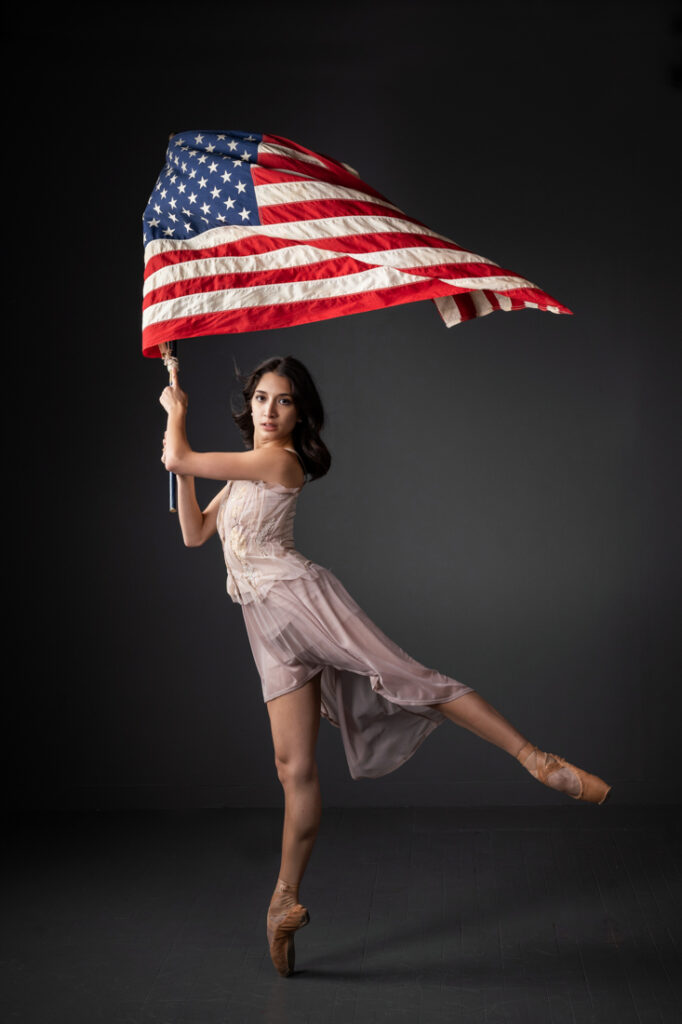

Dani. So, with this emotion, you’re referencing presence in the body, both in your musical work and your photography. From what I’m hearing, it seems like you’re not asking people to be outside themselves in a way that often makes things less meaningful.
Tina. Yes, and when you as a viewer look at a photograph of somebody who’s fully aligned and they’ve got that power coming through their eyes, their face is relaxed, and they’re confident — there’s this connection that happens, I’ve noticed. It just allows people the freedom to go more deeply into the image.
Dani. That’s beautiful. Is there anything else that we haven’t asked about that you would like to talk about?
Tina. I think the other part about the instigator is that people often say they don’t know how to make a difference, they don’t know what to do. And we all carry around these cameras with us, you know? So, if we ask ourselves the question of what does that look like? or whatever your cause is, whatever it is that you want to shed light on, maybe you can Pinterest it, you can Google it, there’re so many ways. If you need inspiration, just look online, ask what have other people done in those areas?, and then find opportunities to share beauty that resolves a concern. And maybe just share that experience online, and it’s really as simple as that, you know?
That’s what I’ve learned about the art world: it doesn’t have to be this big performance. It can just be a moment that passes by but changes our lives.
This interview has been edited for length and clarity.
